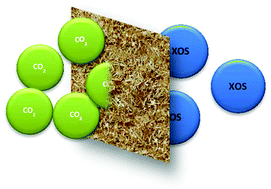The CO2-assisted autohydrolysis of wheat straw
Abstract
The CO2-assisted autohydrolysis was used for wheat straw treatments at temperatures ranging from 180 to 210 °C and an initial CO2 pressure of 60 bar. The study was performed using three different mixture loadings, such as 250 g of H2O/25 g of wheat straw, 150 g of H2O/15 g of wheat straw and 75 g of H2O/7.5 g of wheat straw. The in situ formed carbonic acid was found to result in a higher dissolution of xylose as well as XOS (xylo-oligosaccharides) in comparison to CO2-free pre-treatments under the same conditions (temperature and LSR). The effect of CO2 concentration was also investigated to address the issue of CO2 involved in the reaction that allows to significantly increase the XOS content. At 210 °C with a mixture loading of 75 g of H2O/7.5 g of wheat straw, XOS were present in the liquor at a concentration of 15.75 g L−1. However, with more severe conditions more degradation products (mainly furfural) were detected (in the liquor and the recovered gas phase from depressurization after the reaction). Glucan was mainly retained in the solid phase (containing up to 64%) together with Klason lignin (maximum dissolution of 18%). The dissolved XOS in the liquid phase are proposed to be used in other applications, either directly, such as prebiotic ingredients, or indirectly, after post-hydrolysis to biofuel production through C5 sugars’ fermentation.


 Please wait while we load your content...
Please wait while we load your content...